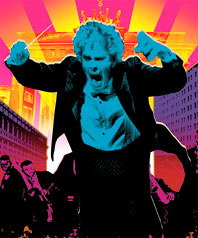 |
Illustration by Sean McCabe
|
New Yorkers hold it as gospel that they live in the best of cities in the best of times. But Clive Gillinson, the former Londoner who now runs Carnegie Hall, suggests another heir to 1830s Vienna, 1920s Paris, and 1960s London. “There are times when you feel that a city is almost the center of the world,” Gillinson says. “At the moment, it’s Berlin.”
Gillinson’s institution will make that case in spectacular detail in November, with a multi-venue festival that brings the German capital’s buzz to our own backwater. The title, “Berlin in Lights,” evokes “Berlin im Licht,” a 1928 fair sponsored by the local electric company and made memorable by the tune Kurt Weill wrote to publicize it, and the new New York edition gives a flavor of Berlin’s ferment, its mix of historicism and relentless novelty. In Carnegie’s Zankel Hall on November 3, for instance, musicians re-create the music from the 1927 silent film Symphony of a City. Two days later, the electronica ensemble Nomad Soundsystem arrives from a city that has been utterly transformed.
When the Berlin Wall fell in 1989, it released a jolt of artistic energy that continues to crackle. Finance and industry had fled, and the city remained relatively inexpensive, so artists weren’t being gentrified out of town. “Everything about the rebirth of Berlin has been generated by culture,” Gillinson says. It’s a perpetual seventies Soho. Because East Germany had its stockpile of cultural institutions, the reunited city has more theaters, opera houses, and symphony orchestras than it knows how to absorb.
The titan among them is the Berlin Philharmonic, a group that under the conductor Sir Simon Rattle manages to seem simultaneously fresh and august. In New York, the orchestra will overshadow its own high-gloss performances of Mahler—by playing as a pit band for a bunch of schoolchildren in upper Manhattan. “The Rite of Spring Project” replicates a wildly successful Berlin experiment: The Phil’s musicians will coax public-school students who have never seen the inside of a concert hall to compose and perform their own collective version of Stravinsky’s ballet, using whatever instruments and voices fall to hand. At the same time, choreographer Royston Maldoom will hammer more than 100 neighborhood kids into a dance corps. The resulting performances will take place not at Carnegie but at the United Palace Theater, the ornate former movie house on Broadway at 175th that’s now the Christ Community United Church. (Where better to reenact a pagan ritual in which a virgin dances herself to death?) “Within a short time, these kids will have created a dramatic, powerful, and genuinely professional performance,” Gillinson says, a promise that would strain credulity if a documentary called Rhythm Is It! didn’t show Maldoom browbeating a crew of Berlin adolescents—a Nigerian refugee, a Muslim girl in a head scarf, a poor kid from the city’s eastern precincts—into a bona fide company. “Don’t think that we’re just doing dancing,” he hollers. “You can change your life in a dance class.”
That statement may sound especially self-evident in Berlin, which is a patchwork of memories, ruins, old neighborhoods, and new construction, stitched together in a youthful, festive pattern. If “Berlin in Lights” gets the atmosphere of today’s German capital right, it will convey the sense of a venerable culture open for negotiation and playful reinvention.

